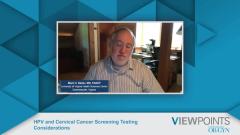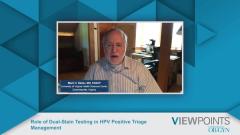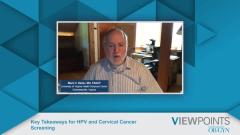
HPV and Cervical Cancer Screening Testing Considerations
Experts in obstetric and gynecologic management examine conventional cervical cancer screening strategies and consider their specificity and sensitivity targets.
Episodes in this series

Dr Thomas C Wright Jr: Let's move on to now discussing the guidelines. What tests are available, and what are the HPV testing and cervical cancer screening guidelines? Basically, we have 3 methods which are in use in the United States. One would be HPV testing alone. Another is co-testing using cytology and an HPV test. There are different guidelines for these. Some organizations recommend HPV primary screening beginning at age 35. Other recommend co-testing beginning at a later age. Could we comment on the specificity and sensitivity of those 3 testing methods: HPV, cytology, and co-testing? Mark, do you want to address sensitivity targets?
Dr Mark H. Stoler: Sure. What sensitivity basically means for the patient and for the clinicians, the sensitivity of the test is what drives the performance of screening. You're trying to reassure patients who are mostly negative. We do HPV testing in the United States with current FDA-approved tests, 10% to 15% of women are positive. Eighty-five percent are negative, and you want negative to mean safe. What we've learned in the last 10 to 20 years is that a negative pap which we used to think that's safe, only means you're safe for about a year or so. It doesn't really predict long-term in the future safety because it's not that sensitive, 50% to 70% sensitive for people who have precancer. HPV testing on the other hand dramatically increases sensitivity into 95%, less than a 5% chance that you have pre-cancer or cancer if you have a negative HPV test. The perplexing thing to me as someone who's been following this field in trying to provide data on the performance of primary screening vs co-testing is that adding the pap to the HPV test doesn't really add much in terms of sensitivity. In many studies, it's statistically insignificant, so why haven't we converted to primary HPV which gets you the sensitivity that drives screening by itself. Part of it is as alluded to laboratories offering primary testing which has to do with which HPV tests they're doing because not all the HPV tests on the market are FDA approved for primary screening, but I think more of it is just this lack of recognition by patients and clinicians that you don't need both tests to really have the screening performance that you want.
Dr Thomas C Wright Jr: Dr Hill, do you agree with the fact that we don't need both tests to screen?
Dr Emily K. Hill: That's a complicated question. I think that HPV, like Dr Stoler said, is clearly where you're going to get your sensitivity with regard to identifying women at risk for cervical dysplasia or cervical cancer. I think where the challenge comes in is the specificity in that with HPV primary screening, especially focusing on that alone, especially in populations that haven't had as much of an uptake of HPV vaccination as we'd like, which the US is, unfortunately, 1 of those populations; you are going to find a lot of women, especially young women, especially if you go with some of the screening approaches where you're starting earlier like the ones that start at 25. You're certainly going to pick up a lot of women who are positive for HPV, but maybe transiently and then therefore not as high of a risk of having dysplasia. I think that's where potentially there is sometimes room for the cytology and/or other tests which I think we'll talk about a little bit later relating to p16 and Ki-67 helping us triage those women to who really needs colposcopy.
Dr Thomas C Wright Jr: Dr Sheth, what does an HPV test tell doctors about a woman's risk of cervical cancer which is different than what you would get with cytology?
Dr Sangini S. Sheth: I think that that is the heart of the role of HPV testing because HPV tells us about the presence or absence of the risk factor for cervical dysplasia and cervical cancer. Whereas cytology is looking for already existing abnormalities of the cells of the cervix. We are more upstream when we're looking for HPV in looking for the risk factor itself. Then as we discussed earlier, then there's opportunity to look for the persistence of HPV infection and act on the persistence because so much of HPV infection does spontaneously clear.
TRANSCRIPT EDITED FOR CLARITY
Newsletter
Get the latest clinical updates, case studies, and expert commentary in obstetric and gynecologic care. Sign up now to stay informed.




















